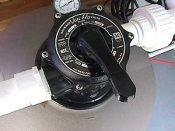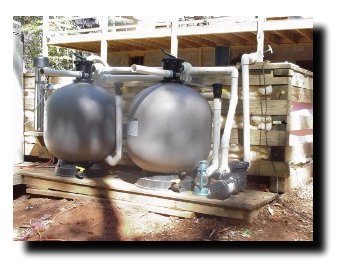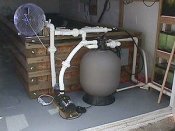This is one of the filters which I [Dr. Johnson] have used extensively at my home*. I still have a 2.2
*Aquadyne 2.2 on 1,000 gal water (2018)
Where to Buy: With a Return Policy (Thank you, Amazon!)
Bead filtration appealed to me because prior to bead filtration, I’d been using sponge filtration, matting filters, and lava rock filters. These filters ALL worked super. I have no complaint about these filter types as far as keeping fish healthy and I show you all these designs in this web site! I am not condemning the technologies.
BUT, when it came time for filter cleaning, I was completely miserable. The sponges weighed a ton, got me filthy and dirty, and always spoiled the water when I put them back in. The matting filter was not as bad, but it didn’t work as well as the sponge filter. The gravel filters I was using were great, but man that gravel wore out my fingertips at cleaning time. And it made a fetid mess.
*Since then I pay someone for the effort.
Needless to say when I heard about Beads, I was “all about” a filter which was easy to clean and would work better than anything I was using before. Or so they said. But it turned out to be true – Bead Filters work great. And nothing wears out, the media isn’t expended or short lived!
I have used about seven different models or brands of bead filters over the years including the Bubble Bead 1, the Bubble Bead 2 and the FluidBead, HydraBead, Challenger, Aquadyne 2.2, and Aquadyne 4.4.
 That’s been sort of an odyssey, because each filter has it’s drawbacks. A major plus to Aquadyne is that there’s no “plumbing” inside the Aquadyne. It’s made on a computerized machine and not with 2″ PVC either.
That’s been sort of an odyssey, because each filter has it’s drawbacks. A major plus to Aquadyne is that there’s no “plumbing” inside the Aquadyne. It’s made on a computerized machine and not with 2″ PVC either.
Okay I won’t continue to bore you. You should just look at the guts of the filter and you’ll see the difference. GUTS
Aquadyne isn’t a sand filter or hacksaw and glue bead filter. It’s a patented design which has given me NO trouble over the last six or seven years.
Anyway, the Aquadyne has been working at my house for about six years now. I’ve used their 2.2 and the 4.4 and now I use two, tandem 4.4 filters. I truly believe in “overkill” when it comes to the media. It doesn’t cost much more for the extra capacity and the practice of oversizing a filter at startup anticipates that fish grow prodigiously.
The Aquadyne is a major advance in bead filtration. It was one of the first filters to use a multi-port head and gives easy access to the beads unlike the older Bubble Beads. I am very fond of these filters. 
The Aquadyne filter is retailed at various outlets including AquaDynamite.com. They have a money back satisfaction guarantee which is a good thing when trying something out for the first time.
I am impressed by the AquaDyne for several reasons:
Using a multiport inlet, they have a rinse feature which allows you to discharge the first few gallons of water returning to the pond after cleaning.
Because of the filter body being used for this design, there is also a bypass feature which allows you to continue the un-interrupted flow of water, but the water completely bypasses your bead cake. This can be a priority when using short term medications such as Formalin which could negatively impact your filters’ biological bacterial flora.

Also, the AquaDyne has NO elbows inside. The patented “column” inside is a stroke of simple genius. The column is made of precision, machined parts and cannot be copied by a hobbyist for a home-made version. There are several design concepts which are so axial that unless a person had a fully equipped machine-shop, they could not reproduce this “column” at home.
The absence of elbows allows massive throughput of water. I was amazed to see that the filter throttles the flow down to 1.5 inches at the head, but returns through a two inch pipe at a rate sure to please anybody. Now, the AquaDyne can ship with an even higher efficiency head. This unit has four throughput pipes.
*I have used (and endorsed) other filters but this was based on their performance and not their longevity. One of the filter-types I was using ended up clogging and had to be completely disassembled for cleaning. It’s the dumbbell shaped one*. My first introduction to Bead filters.
*since then, air wash technology is available for Bubble Bead filters.
The next kind of filter was snazzier but it ended up choking on its own check-valves. Never buy a filter which relies on internal check valves. They always fail.
Aquadyne Cleanout Super Thorough
“The Big One” Super Cleaning Method.
This is the “Big One – Annual Super Cleaning Routine” I perform once per year on mine.
Before you stop the pump, open the sludge drain near the bottom of the filter (it’s a ball valve) and note the amount and type of discharge. I have met people who have NEVER opened this sludge drain! Close the sludge drain as soon as the water runs clear-ish.
Stop the pump.
Open the ball valve on the blower riser.
Put the control head to “Backwash”.
Start the blower.
Count to “seven-one-thousand” (Seven elapsed seconds if you have a timer)
Stop the blower.
Turn the control head to “Rinse”.
Start the blower again.
The filter should shake, rattle and jump now.
Run the blower until water stops coming out of the filter discharge line.
Or, stop the blower after 4-5 minutes.
Close the ball valve for the blower. You’re done with the blower functions.
Have the control head set on “Backwash”
Restart the pump.
When discharge starts running clear, stop the pump.
Reset the head to “Rinse”
Restart the pump.
No water will come out the discharge line for a while. The filter is refilling.
When water starts coming out of the discharge line – stop the pump.
Reset the head to “Backwash” again
Start the pump again, on “High” if it has this setting.
When discharge appears to clear, stop the pump
Reset the head to “Rinse” again.
When discharge line is clear, stop the pump.
Reset the head to “Filter”.
Restart the pump.
THEN DON’T FORGET TO: Open the sludge drain once again while pump is running and marvel at the ‘crap’ that blows out.
Parts identification image:






